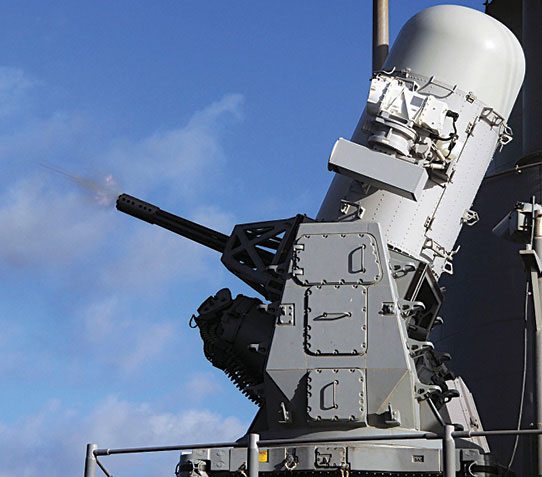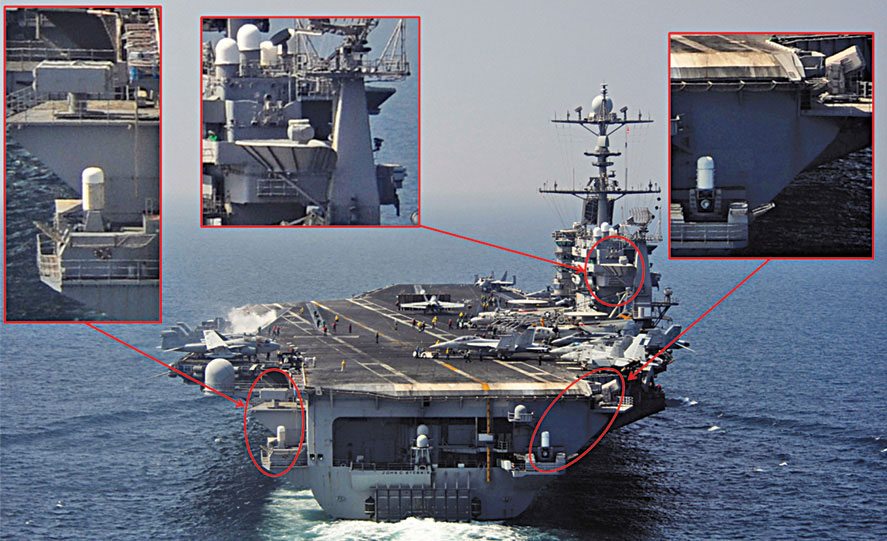It is flexible in a way that pulse widths and pulse-repetition frequencies (PRF) of radar energy can be varied, accordingly, for the desired resolution. A higher PRF setting and short pulse width increases the resolution to detect two smaller targets in close proximity to each other. Other settings may even show these two targets as a single large target. But other settings also have different uses; the operator chooses the settings accordingly.
AN/SPQ-9 air and surface surveillance radar. This is an air and surface surveillance X band-phased array radar. It covers 360° in azimuth at the rate of 30rpm. This allows the radar to detect sea-skimming missiles at the horizon against the presence of heavy sea clutter. It automatically displays any target with a relative speed exceeding ten knots. It complements high-altitude surveillance radars by detecting missiles that are approaching just above sea surface.
In surface mode, it generates a separate surface frequency to detect surface targets. It can even detect a submarine that has partially submerged and is just peeking its periscope above the water surface.
The radar is present in Aegis vessels also, where it helps these to fire accurately on the enemy surface vessels.
Rolling airframe missile (RAM). This missile is carried in bulk in its launcher. It is capable of reaching mach 2 speeds with an effective range of 9km. It is independent of any radar and has a passive radar-homing guidance. It targets the incoming cruise missile by homing on its radar emissions.
Generally, anti-ship cruise missiles have radars as seekers. RAM looks for radar emissions, finds these, locks on these and flies towards these. Also, RAM can target infrared (IR) emissions that are abundantly available in the incoming cruise missile’s engine exhaust. As the missile’s exhaust is very hot, it emits IR radiations like a hot iron emitting red light.
Both Sea Sparrow and RAM have a minimum range beyond only which these can engage. These need time, at least a fraction of a second, to pick up maximum speed. The range at which these pick up maximum speed is their minimum range. It is highly difficult for RAM to manoeuvre towards the target before the minimum range with speed building up. If the incoming cruise missile escapes interception and closes in rapidly, air defence warfare progresses to close in defence.
Phalanx close-in weapon system (CIWS). CIWS is a rapid-firing Gatling gun. Gatling guns have rotating multiple barrels. Gatling gun, developed by Richard Gatling, was the first machine gun in the world. In the past, the gunner had to rotate a crank handle to rotate the barrels in the first Gatling machine guns. But CIWS uses motors for this purpose. At an astounding rate, CIWS shoots tungsten or depleted uranium tipped bullets. These bullets are known for their hardness, so the sheer number of these fired can literally shred incoming cruise missiles into pieces.

How does this last line of CIWS defence work? CIWS is generally kept as an independent and automatic system but with manual override features. It has its own set of radars, a search radar and a tracking-cum-fire-control radar, to ensure last-resort air defence capability. For example, if SSDS connectivity is lost, CIWS can take care of missile defence.
These radars operate at 9200MHz-9250MHz band and are capable of emitting energy at a peak power of 1.4kW. The search radar keeps on scanning its sector around the carrier. If a target appears, it gives the bearing, range and altitude of the target to the FCS of CIWS.
FCS first checks if the target is approaching the carrier. If it is outbound, CIWS discards it. But if it is inbound, the track is taken as bogey (possible enemy). Now, FCS determines whether the bogey is in a collision course with the carrier by extrapolating the trajectory of the bogey through radar data. It also checks the speed of a bogey that presently is not in collision course. It does this to determine whether the target can manoeuvre to a collision course at a later stage.
If these assessments are positive, FCS instructs the tracking radar to start tracking the bogey. When the bogey reaches within the gun’s range, FCS commands the gun to start firing. Guns fire at a point where the bogey arrives in a few fractions of seconds. The tracking radar also tracks the trajectory of the bullets to check if these deviate due to any environmental parameters. If so, FCS fires the guns accordingly to offset the deviation.
Typically, CIWS first finds the targets at 8km from the carrier. If it detects that the target is inbound and flying between speeds of 140 knots and 1600 knots, it starts tracking the target at 5km. CIWS can detect and track a target flying at an altitude of 8km.

A typical USN carrier has three CIWS located strategically at the corners. So at any point of time, two CIWS can engage a single bogey to maximise the chance of destroying it. Each Aegis destroyer and cruiser has two CIWS to protect themselves.
Latest CIWS versions have EO sights (thermal imaging cameras) for the operator to distinguish a bogey from a friendly aircraft with his own eyes even in dark. Since CIWS does not have an inbuilt IFF, only SSDS supplies IFF data. So if SSDS connectivity is degraded, in automatic mode CIWS considers even a carrier-borne aircraft approaching to land as bogey and shoots it down.
Electronic warfare (EW) suite. The EW suite is also integrated with SSDS to divert the missile by spoofing it. This spoofing attempt is the soft killing of the incoming missile. It may precede a SAM interception or take place along with the interception.
B. Kamalanath is a technical writer. He is also a research scholar, pursuing Ph.D in military technology










